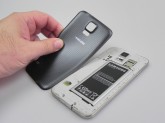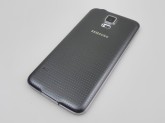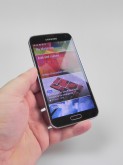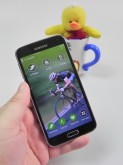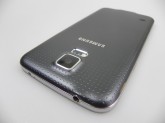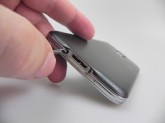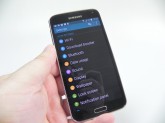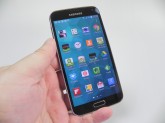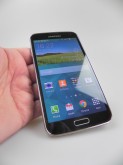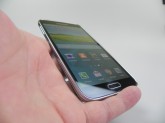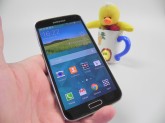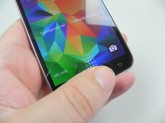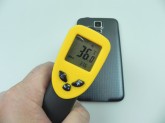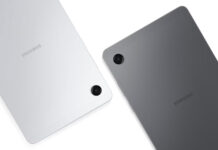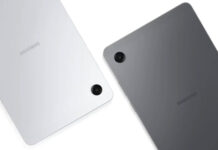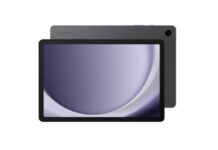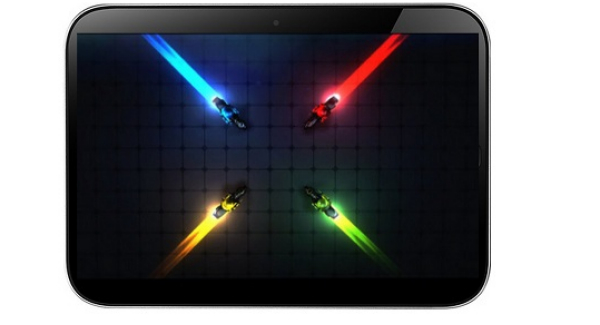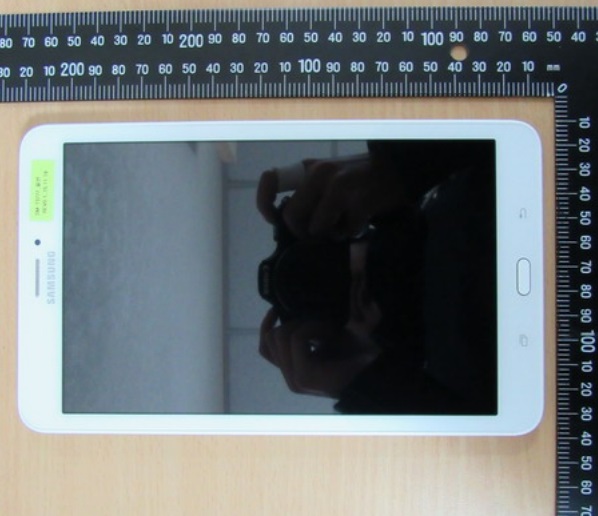Since Samsung Galaxy S5 has gone over the threshold of 5 inches we might as well review it right here at Tablet-News.com. The phone was announced at MWC 2014 during a special event and it was launched in the stores on April 11th. This device has sold up to 100% more units than the Galaxy S4 in its first days since its launch, so it’s already a hit. Let’s see how much of a hit it is to us…
Priced at $199.99 on US carriers on contract and between $600 and $700 off commitment, the device features a design that’s longer and wider than the Galaxy S4. The thickness here is 8.1 mm and the weight is 145 grams. The handset is available in black, white, a beautiful electric blue or copper gold. It has good grip and it’s both waterproof and dust proof.
The phone has a back texture that reminds me of a golf ball, with all those perforations, but when you’re touching it, it feels like some sort of cardboard or a bandaid. There’s a lid over the microUSB 3.0 port for the sake of waterproofing, but that lid feels a tad fragile and may get in your way sometimes.
The Home button is pretty rigid, but the general format of the device is pretty good and comfy. The Galaxy S5 sits well in the user’s hand and once you remove the back cover you’ll see that the microSD and microSIM slots sit on top of each other and you have to remove the battery to insert the microSIM.
We’ve got water seals under the cover and this model comes with IP67 protection, meaning it can work when dipped into water depth of 1 meter and for about 30 minutes. The design seems rather inspired by the Galaxy Note 3 and the small hand users will find this device to be pretty big for them. The case is made of plastic, make no mistake here.
At the top we find the audio jack, infrared emitter and a mic, while at the bottom there’s the microUSB 3.0 port and another mic. On the left side there’s the volume buttons, while on the right we’ve got the On/Off button, all of them very comfy and with good feedback. At the back there’s the camera with flash and the heart rate sensor, plus speaker.
Upfront we’ve got a Home button (physical) and two capacitive buttons (Back and Recent Apps), plus the earpiece, front camera, holes for sensors (ambient light, proximity, infrared, gesture sensor) and notification LED. Overall the design is comfy for big hands and this is quite a bit bigger than the Galaxy S4. As far as the hardware goes, the Samsung Galaxy S5 features a 5.1 inch Super AMOLED display with a Full HD resolution and Gorilla Glass 3 protection. It has a 432 ppi density and specs also include a quad core Snapdragon 801 2.5 GHz processor, with Krait 400 cores, as well as an Adreno 330 578 MHz GPU.
There’s 2 GB of LPDDR3 RAM on board, 16/32 GB of storage, plus a microSD card slot with support for up to 128 GB of extra storage. The phone integrates a 16 megapixel back camera with LED flash and a front 2 MP shooter. We’ve got a microSIM slot inside and on the connectivity side there’s quad band GSM/GPRS/EDGE, HSDPA with 42.2 Mbps download speeds, LTE, infrared, GPS, Glonass and microUSB 3.0 with MHL 2.0. We’ve got Bluetooth 4.0 on board, NFC, DLNA, WiFi 802.11 A/B/G/N/AC, WiFi dual band and WiFi Direct.
Finally, the Galaxy S5 packs an accelerometer, proximity sensor, gyroscope, compass, heart rate sensor, fingerprint scanner and it doesn’t have a thermometer, as I wrongly stated in the video review. We move on to the battery, which is a Li-Ion 2800 mAh unit (10.78 Whr), that on paper offers 390 hours of standby functioning or 21 hours of talk time.
In our test, that involved HD video playback with WiFi on and brightness at 50% we achieved 11 hours and 4 minutes of video playback, which is very good, especially considering the arch rival of this model, the HTC One M8 only scores 10 hours and 15 minutes of playback, while the LG G2 only reaches 9 hours and 15 minutes.
The charge is done in a bit less than 2 hours, which is also very good. Then there’s the power saving, both the regular one, that blocks background data and restricts CPU performance, screen performance and cuts off the GPS, plus the brand new Ultra Power Saving mode. This mode offers a grayscale theme and makes the phone work with limited features. For example in this mode you get 4 days of usage with 30% of battery. The WiFi and Bluetooth are turned off, as is the mobile data when the screen is off.
The screen goes to 87 nits units and the CPU goes to 1.5 GHz, while the refresh rate becomes 30 Hz down from 60 Hz. With 10% battery you should get 24 hours of standby functioning with this model. So, overall the battery is very good. As far as the acoustics are concerned, the video player has a new icon, but keeps the general lines of the UI from the previous TouchWiz. The tunes are organized in Tracks, Albums, Artists, Music Square (moods), Folders and Devices.
The speaker is pretty loud, but obviously not as loud as the HTC One M8 BoomSound speakers, but still louder than an iPhone. The high notes are well heard and at max volume you’ll feel the back of the phone vibrating, which is not exactly a nice feel. The bass is decent and the Settings area gives you access to a pretty complex EQ, that’s dubbed SoundAlive.
Here we’ve got options like Tube Amp, 3D, Bass, Clarity and some custom EQ options. There’s also Adapt Sound, a system for tuning headphones for the experience, play speed, lyrics and Smart Volume to adjust the next tracks to the previous ones’ volume. The volume is about the same quality as the one of the Galaxy Note 3 and meanwhile the headphones are just like the ones we got with the Galaxy S3.
The player offers FLAC support and we’ve got support for full screen album art on the lockscreen. The sound is clean and the headphones are loud and clear, plus they offer a good bass, pretty much on par with the Apple EarPods. Overall the audio is good, better than most Android phones. Moving on to the display, this is a 5.1 inch Super AMOLED Full HD unit, that’s very crisp and bright and it’s a clear evolution from the Galaxy S4 display.
The colors are vivid and accurate here, contrast is good and the handset behaves well in sunlight. The view angles are wide and the Lux level on white is 480, that highest we’ve registered with our luxmeter on any handset. It’s a huge step up from the 206 lux units of the Galaxy S4, that’s for sure. Meanwhile, the HTC One M8 gets only 463 lux units. The pixels are of the Pentile Matrix kind, by the way.
The screen is better than the one of the HTC One M8 and we’ve got very deep black, with zero lux, plus low reflectivity. The video player offers typical Samsung features like Pop Up Play, subtitles and the settings area includes brightness, Sound Alive and Play Speed. You can zoom in during playback and you should know that while there’s no DivX support here, at least there’s MKV support. Settings for the screen include Smart Stay, that keeps the display on while your eyes are detected, plus Adapt Display, with a variety of options for the viewing experience.
We’ve got Dynamic, Standard, Professional Photo and Cinema, the latter with the best colors available. We’ve also got an option called Auto Adjust Screen Tone, that saves power and one that increases touch sensitivity if you use the handset with gloves. Right now, the Samsung Galaxy S5 has the best display on the market in 2014 and only the iPhone 6 may challenge it in the months to come…
Samsung Galaxy S5 has a 16 megapixel camera and it’s the first phone to use the ISOCELL sensor technology. The sensor size here is 1/2.6 inches and this one is a 16:9 sensor, that can generate 1.12 micron pixels in shots. ISOCELL is a technology from Samsung, that reduces crosstalk between the pixels and introduces barriers between individual pixels. We’ve got a single LED flash, a powerful one and upfront there’s a 2 MP shooter. The ISOCELL also means that we get better low light shots and improved color accuracy, plus sharpness.
The aperture of the camera is F/2.2 like the Galaxy S5 and the focal length is 4.8 mm, compared to the 4.24 mm of the Galaxy S4. The focus takes place in 0.3 seconds just like on the HTC One M8. The UI is different compared to the Galax S4, it’s more centralized and at the top left you’ve got the front camera, while at the middle of the screen on the left there is space for 3 custom options.
The default ones are selective focus and HDR. Selective Focus is a feature that allows you to change focus on objects in the foreground or background according to preference. It’s a bit like the Upfocus feature on the HTC One M8 or the Refocus from Nokia Lumia. It takes a series of shots with various focuses objects, but in our tests it simply wouldn’t work.
The idea is to have a subject at a distance of 45 cm and the background 3 times as far. We lined them up and still it wouldn’t work. The HDR though works just like, it’s very good and fast, plus it’s very efficient. The settings include picture size, with a max resolution of 5312 x 2988 pixels in 16:9, then come options like Burst, picture stabilization, face detection, ISO (up to 800), metering (center/matrix/spot), tap to take pics and then some video options. Those include filming resolution, up to 4K, slow motion capture, fast motion and smooth, meaning Full HD in 60 FPS.
There’s video stabilization, audio zoom, that allows you to focus the audio capture on the area you’re video zooming on, plus a bunch of effects including vignette, vintage, sepia, cartoon and fisheye. There’s flash, timer, remote viewfinder, white balance, exposure, voice control, guide lines and that’s about it, as far as the centralized options are concerned. The modes are placed on the right side of the UI and include Beauty Face, that eliminates all imperfections of faces, Shot + Mode, that’s basically a collection of features including Best Photo/Best Face/Erase/Drama Shot/Panning Shot. This way you take multiple shots and then activate the options needed.
Panorama is also here, as well as Virtual Tour, a sort of first person 360 degree panorama, allowing you to make a virtual tour of a house or area, with a map included. There’s Dual Cam, Animated Photo demoed in the video review and Sound and Shot, that’s basically a picture with a few seconds of sound. Then we’ve got Sports for fast moving objects, the Surround 3D panorama and you can download more modes in the future, like the Nokia Lumia lenses.
The camera does 4X zoom max and that happens fast and without flaw. Now, as far as the actual picture taking is concerned, the day time shots have accurate colors, good level of detail, good brightness and the flowers you see in the gallery are actually “oversaturated” in real life, so the camera is not playing any tricks on you. The Macro like the cherry flower shot is perfect and the Panorama goes up to 60 megapixels. I’d say this camera beats the one of the Xperia Z1 and goes dangerously close to a 20 MP Pureview. The day time shots were very good and so was the HDR. The night time shots have good clarity and the flash was powerful enough to light up the photographed objects.
A ton of photo samples I’ve taken with this phone are HERE.
The light sources are a bit blurry and the night time filming is kind of weak, below the HTC One M8 and clearly below the quality of the Nokia Lumia Pureviews. A slight progress from the Galaxy Note 3 can be felt, though. As far as daylight filming goes, the cherry tree video shows that you can get a nice bit of zoom with good detail, the colors are vivid and both the slow mo and fast motion vids look great. You can film in 4K and it looks great, with the image being very crisp. The result of video capture are MP4 files, either 1080p at 30 FPS with a 17 Mbps bitrate or a 60 FPS sample with 28 Mbps bitrate.
The 4K one goes up to 48 Mbps. Audio is stereo and the bitrate here is 128 Kbps, while the video zoom quality is very good. Samsung Galaxy S5 has the best camera of a 2014 phone so far, but we haven’t tested the Sony Xperia Z2, so maybe there’s room for improvement. It’s clearly above the Note 3, iPhone 5s, Xperia Z1 and HTC One M8 for now. By the way you can also do some photo editing, since Samsung also integrated some features of this kind. You can enhance your sample, rotate, crop, resize, change tone, tweak contrast, saturation, brightness, hue, red, green, blue or apply effects and play with faces by removing red eyes, airbrushing them and brightening them.
Stickers, labels, text and frames and can be applied as well. Now we’re totally done with the photo section and we move on to performance. The Samsung Galaxy S5 reaches 37.6 degrees Celsius after 15 minutes of gaming, so it doesn’t overheat one bit. Now, on to the benchmarks! I decided to compare the S5 with the HTC One M8, Sony Xperia Z1 and the iPhone 5s. In Quadrant Samsung Galaxy S5 scores 22739 points, below the HTC One M8’s 24k and above the Xperia Z1’s 20k. In AnTuTu we get 34.712, above the HTC One M8 by 200 points and passing the Xperia Z1 by 300 points. NenaMark 2 brings a score of 60.1 FPS for the S5, only a fraction of a frame per second higher than the rivals.
In Vellamo there’s a bit of a compatibility issue, since at 1645 points we’re much lower than the Xperia Z1’s 2942 points. 3DMark is more relevant with a score of 18632 points in the Unlimited test, beating the other two models by 1k and 2k points respectively. In the download speed test we achieved 23 Mbps and 24 Mbps in download/upload, beating the HTC One M8’s 20/20 Mbps.
Next up we’ve got GeekBench 3 and a single core score of 854 on the S5 beaten by the iPhone 5s 1410 points and the 979 of the HTC One M8. We also got beaten in the multi core test, with 2553 vs 2900 on HTC One M8 and 2563 on the iPhone 5s. GFXBenchmark gave us 27.4 FPS in the offscreen 1080p test, below the HTC One M8 with 28 FPS and above the iPhone 5s with 25 FPS.
BrowserMark 2.0 had us at 3250 points and Sunspider at 413, so we’re doing fine in the browser area. Overall, the S5 won 5 out of 10 benchmarks against the other models and 6 out of 10 versus the HTC One M8. Call quality is even above the iPhone, which is high praise nowadays and the volume beats the HTC One M8’s.
As far as the browser is concerned, it’s fast, it has smooth scrolling and a good looking tabs system. The S5’s keyboard is very well spaced and it offers much more comfy input compared to the HTC One M8 for example, that’s a bit more cramped. And now on to what makes the S5 special: heart rate sensor and fingerprint scanner. The first is useful if you work out, but it doesn’t exactly function at maximum capacity all the time. Most of the times you’ll be either placing your finger wrong on the sensor or the system won’t detect you.
Or the system is plain wrong about your pulse, something I’ve seen confirmed by other health devices. The fingerprint scanner is PayPal certified, although even that has been hacked recently. It uses Synaptics technology and the sensor is placed below the Home button. You need to swipe over it down on the display and make it a slow movement, so don’t rush it. The smartphone stores 3 fingerprints and you can use a password as a backup if you want.
With this system you can do PayPal payments, unlock the phone, access a special locker where you keep your secret files an all that. To me the iPhone 5s Touch ID is only slightly better than the S5 biometric system, because it’s a tad faster. On the UI side, the new TouchWiz is flatter and based on a lot of circles. There’s a new font here and KitKat elements, like the transparent search bar for example. We’ve got a new look for the multitask area, more aired out now and the notification area includes new options, such as Toolbox, Car Mode and Private Mode.
In the settings area you’ll find a new feature called Download Booster, that combines the LTE and WiFi into a connection with super download speeds. Other settings include One Handed options, the usual gestures and motions, Easy Mode, Blocking Mode and Air View, all of them known from previous Galaxy S and Note models. If you keep swiping to the right of the screen you’ll trigger the Magazine Mode, a BlinkFeed alternative based on FlipBoard. It’s a news aggregator with social networking integrated and paginated like a magazine.
It’s based more on pictures than text, at least at first site and you deactivate it if you don’t like it. The preinstalled apps list is as usual huge, since this is a Samsung product after all. In my case it included Evernote, Flipboard, Memo, My Files, the Play Suite and famous S Health, with its pedometer, food info, exercise, heart rate and graphs of your progress. There’s the S Planner calendar on steroids and S Voice, that’s totally far from Google Now and Siri as far as performance goes.
Samsung Apps takes care of your apps, but you’ll use it rarely, while Smart Remote works your IR emitter and turns the handset into a remote control. Other things worth mentioning here are the very cure Kids Mode, that changes the UI into a cute childish experience, with crocodiles and other funky icons and widgets and hides mature content and features.
Then there’s Geo News, a feature that lets you know about disasters in your area and a special accessory triggered function, that shows you a bunch of media apps in the notification area once you connect a pair of headphones for example. And now we’re all done, so it’s time for the verdict!
Here are the Pros of this device:
- waterproof and dustproof
- powerful hardware
- fingerprint scanner and heart rate sensor
- S Health is always good to have
- a ton of sensors
- perfect screen
- very good audio
- lots of photo editing options
- lots of camera options
- 4K video capture
- very good battery
And the Cons:
- less premium materials compared to rivals
- fingerprint and heart rate scanner don’t work impecably well
- no optical image stabilization
- mono speaker
- bloatware
- camera UI is crowded
- new UI is not very effective or pretty
- S Voice is useless
- the handset is big and wide for small hands
- Selective Focus doesn’t work most of the time
We give the Samsung Galaxy S5 a 9.4 out of 10 for design, a 9.8 out of 10 for hardware and a 9.2 out of 10 for OS and UI. The final grade is 9.46 out of 10 and I have to say that this is the most featured device I’ve ever played with. If you own a Galaxy S4 or LG G2, it’s not yet time to give them up for the S5. Any device older than 1 year and a half can be replaced by this model… This doesn’t mean the S5 is not one hell of a phone, with the best screen, battery and camera on the Android market for now.
You can buy the Samsung Galaxy S5 on Amazon.
[youtube lfyElhDzkGI 660 520]
Post Footer automatically generated by Add Post Footer Plugin for wordpress.


















